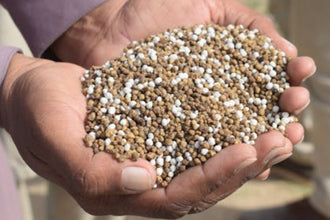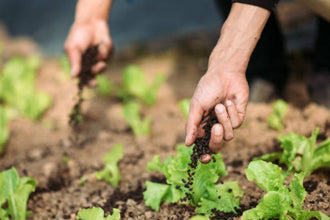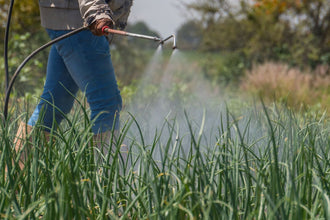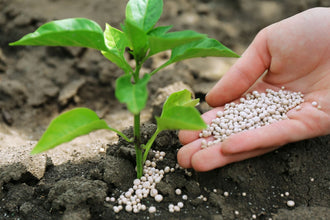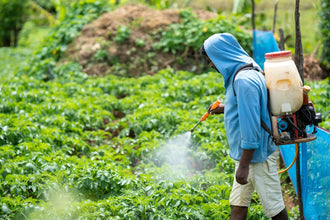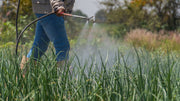
Fertilizer safety matters more than most gardeners realize, even when you're using organic products. You might think natural fertilizers are completely safe, but the truth is any plant food can cause problems if you don't handle it right. Whether you're working with chemical or organic options, knowing how to stay safe protects you, your plants, and everything around your garden.
Most fertilizer accidents happen because people skip the safety basics. They don't wear gloves, they mix products wrong, or they apply too much at once. These mistakes can burn your skin, hurt your plants, or even contaminate local water sources. The good news is that safe fertilizer use isn't complicated once you know what to do.
Getting fertilizer safety right means understanding that these products pack a lot of power into small packages. They're meant to feed plants, but they can also cause real harm when misused. Smart gardeners treat all fertilizers with respect and follow proven safety steps every time they use them.
Different Types of Fertilizers Come With Different Risks
Not all fertilizers pose the same safety risks, and understanding these differences helps you stay safer in your garden. Chemical fertilizers contain synthetic compounds that can burn skin and irritate eyes on contact. When these products get wet, they often release nitrogen gas that can cause breathing problems, especially if you're working in a greenhouse or enclosed space.
Organic fertilizers bring their own set of safety concerns that many people overlook. Fresh manure-based products can carry nasty bacteria like E. coli and Salmonella that make people sick. Even processed organic fertilizers can irritate your skin and lungs if you breathe in the dust while spreading them around.
What Makes Chemical Fertilizers Dangerous
Chemical fertilizers work by concentrating salt-based nutrients into small granules or liquid solutions. These salts pull moisture from anything they touch, including your skin. That's why chemical fertilizers can cause painful burns and irritation when they make direct contact with your body.
High-nitrogen chemical fertilizers create the biggest immediate risks because they release ammonia gas when they get wet. This gas smells strong and can irritate your nose, throat, and lungs. Working with these products in closed spaces makes the problem worse because the gas builds up instead of blowing away.
Storage becomes a bigger deal with chemical fertilizers too. They soak up moisture from the air, which makes them clump together and sometimes causes chemical reactions you don't want. Some fertilizer combinations can even become fire hazards if you store them wrong or accidentally mix incompatible products.
Why Organic Fertilizers Need Respect Too
Many gardeners assume organic fertilizers are completely safe because they come from natural sources. While they're generally safer than synthetic options, organic fertilizers still deserve careful handling. Manure-based products can spread diseases from animals to humans through direct contact or contaminated soil.
Dried organic fertilizers create clouds of dust when you spread them, and breathing this dust can irritate your lungs and eyes. The particles are fine enough to get deep into your respiratory system, causing coughing and breathing difficulties for some people.
The slow-release nature of organic fertilizers means their effects stick around longer in your soil. This creates longer exposure periods for helpful soil organisms and nearby water sources. Understanding these longer-term impacts helps you use organic fertilizers more responsibly.
Personal Protection Equipment Keeps You Safe
Personal protective equipment gives you the best defense against fertilizer safety problems. You don't need expensive gear to stay safe, just some basic items that prevent direct contact with harmful substances. Chemical-resistant gloves, long sleeves, and eye protection handle most situations you'll encounter in home gardens.
Breathing protection becomes important when you're working with dusty fertilizers or spreading them in enclosed areas. A simple dust mask prevents you from inhaling particles that can irritate your lungs and sinuses. If you're applying large quantities or working in greenhouses regularly, upgrading to a proper respirator makes sense.
Your feet need protection too, especially from spills that can soak through regular shoes. Closed-toe shoes with chemical-resistant soles work best for fertilizer applications. Many gardeners keep a dedicated pair of "garden shoes" just for fertilizer days to avoid tracking contaminated materials into their homes.
Picking the Right Clothes
Your clothing choices directly impact how safe you stay during fertilizer applications. Natural fibers like cotton soak up and hold onto chemical residues longer than synthetic materials. Polyester and nylon shed contamination more easily when you wash them later.
Long pants and sleeves give you essential coverage when spreading fertilizers around your garden. This protection becomes especially important on windy days when particles can blow back onto you. Light-colored clothing helps you spot contamination and keeps you cooler during hot outdoor work sessions.
Protecting Your Eyes and Lungs
Eye protection prevents chemical splashes and dust particles from causing serious injuries. Safety glasses with side shields offer better protection than regular eyewear. If you wear prescription glasses, you can get prescription safety glasses that provide both vision correction and protection.
Respiratory protection starts with understanding wind direction and working conditions. Always try to apply fertilizers with the wind at your back so you don't end up breathing particles or spray. Indoor applications need better ventilation and more protective equipment than outdoor use.
Safe Storage Prevents Most Problems
Proper storage prevents accidents before they happen and keeps your fertilizers working effectively for longer periods. Chemical fertilizers need cool, dry places away from heat sources and materials that might react badly with them. Plastic storage containers work better than metal ones because some fertilizers can react with certain metals.
Organic fertilizers need different storage approaches because of their biological nature. These products can harbor bacteria and fungi that multiply quickly in warm, moist conditions. Proper storage prevents contamination and helps your organic fertilizers last longer.
Child and pet safety should drive most of your storage decisions if you have little ones or animals around. All fertilizers belong in locked cabinets or storage areas that prevent accidental access. Even organic products can harm curious children and pets who might eat them.
Controlling Temperature and Moisture
Temperature swings affect how stable and safe your stored fertilizers remain. High temperatures can trigger chemical reactions in synthetic fertilizers, creating toxic gases or even fire hazards. Extreme cold can crack storage containers, leading to spills and contamination problems.
Keeping moisture under control prevents many storage headaches before they start. Dry conditions prevent clumping, unwanted chemical reactions, and bacterial growth in stored fertilizers. Throwing some desiccant packets or moisture absorbers into storage containers helps maintain the right conditions.
Choosing Containers and Labels
Original containers provide the best storage option for most fertilizers because they include important safety information and proper labeling. Transferring fertilizers to different containers often leads to confusion and safety problems down the road.
Clear labeling becomes essential when you're using multiple fertilizer types in your garden. Include application rates, mixing instructions, and expiration dates on every container. This information prevents dangerous mistakes during busy gardening seasons when you're rushing to get everything done.

Safe Application Techniques That Work
Safe fertilizer application starts with reading and following label instructions completely. These directions give you specific rates, timing, and safety requirements for each product. Skipping label instructions leads to plant damage, environmental contamination, and personal injury.
Weather conditions play a huge role in application safety and how well your fertilizers work. Wind spreads granular fertilizers beyond where you want them and blows liquid applications back onto you. Rain soon after application washes nutrients away before your plants can use them.
Keeping your application equipment in good shape prevents many problems. Clean spreaders and sprayers work more accurately and prevent cross-contamination between different fertilizer products. Regular equipment cleaning also makes your tools last longer and prevents rust and corrosion.
Getting Timing and Weather Right
Morning applications often provide the safest conditions for fertilizer safety. Cooler temperatures reduce chemical reactions and keep liquids from evaporating too quickly. Less wind movement prevents drift to areas where you don't want fertilizer. Your plants can start using the nutrients before heat stress kicks in later in the day.
Avoiding applications right before heavy rains prevents nutrient runoff into water sources that you want to protect. Light watering after application helps dissolve granular fertilizers and prevents root burn from concentrated nutrients.
Keeping Equipment Calibrated and Clean
Getting accurate application requires properly calibrated equipment that spreads fertilizers evenly across your garden. Uneven distribution creates spots with too much fertilizer that can burn plants and contaminate groundwater. Areas that don't get enough fertilizer miss out on the benefits you're paying for.
Regular equipment cleaning prevents product buildup that messes with accuracy. Old fertilizer residues can eat away at metal parts and clog the openings where product comes out. Simple cleaning after each use makes your equipment last longer and keeps everything working safely.
Here's what to check on your equipment:
-
Spreader settings match label recommendations
-
All openings are clear of old product
-
Moving parts work smoothly without sticking
-
No rust or corrosion on metal components
-
Calibration still matches manufacturer specs
Protecting the Environment While You Garden
Water source protection should guide every decision you make about fertilizer applications. Nutrients that reach streams, ponds, or groundwater create pollution problems that stick around for years. Creating buffer zones around water features prevents direct contamination during application.
Soil testing shows you what nutrients are already in your soil and prevents over-application. Extra fertilizer doesn't help your plants and increases environmental risks. Testing saves you money while protecting local ecosystems from nutrient pollution.
Wildlife protection means thinking about how your fertilizer applications affect beneficial insects, birds, and other animals that visit your garden. Some chemical fertilizers harm pollinators and soil organisms that keep healthy gardens thriving. Timing your applications to minimize wildlife exposure reduces these negative impacts.
Stopping Runoff and Contamination
Proper application timing prevents most fertilizer runoff problems before they start. Applying nutrients when your plants are actively growing means faster uptake and less waste. Applications during dormant seasons often wash away before plants can use them.
Good soil preparation improves how well your soil holds onto applied fertilizers and reduces environmental risks. Well-drained soil hangs onto nutrients better than packed-down ground where runoff happens easily. Adding organic matter increases your soil's ability to hold applied nutrients where plants can use them.
These practices help prevent environmental problems:
-
Test soil before applying any fertilizer
-
Create 10-foot buffers around water sources
-
Apply only when plants are actively growing
-
Water lightly after application to prevent runoff
-
Never apply before heavy rain forecasts
Emergency Response and First Aid Basics
Knowing how to respond to fertilizer accidents protects everyone in your household. Keep emergency contact information where you can find it easily, including poison control numbers and local emergency services. Quick action turns minor incidents into learning experiences instead of serious injuries.
Basic first aid for fertilizer exposure focuses on getting contamination off your body as quickly as possible. Flush affected skin or eyes with clean water for at least 15 minutes. Take off contaminated clothing right away to prevent continued exposure to harmful substances.
Most fertilizer emergencies involve skin or eye contact, accidental ingestion, or breathing problems from dust or gas. Having a plan for each situation helps you respond quickly and effectively when accidents happen.
Common Emergency Situations
Skin contact usually causes the most fertilizer-related problems in home gardens. Chemical fertilizers can cause burns that look like heat burns but come from chemical reactions. Rinse the affected area immediately with lots of clean water and remove any contaminated clothing.
Eye contact with fertilizers requires immediate action because damage can happen quickly. Flush eyes with clean water for at least 15 minutes, keeping the affected eye lower than the unaffected one so contaminated water doesn't spread. Get medical help right away for any eye exposure.
Breathing problems can develop from inhaling fertilizer dust or gases, especially in enclosed spaces. Get the affected person to fresh air immediately and seek medical attention if breathing difficulties continue.
Start Gardening Safer Today
Fertilizer safety protects your family, your garden, and your local environment through simple practices that become second nature with time. Start by looking at how you currently store and apply fertilizers compared to these proven safety guidelines. Small changes in your fertilizer handling create big improvements in overall safety for everyone around your garden.
Your garden deserves the benefits that proper fertilizer use provides, and you deserve to enjoy gardening without worrying about safety problems. By following these straightforward safety practices, you can feed your plants confidently while protecting what matters most to you. Safe gardening habits develop quickly with consistent practice, making every growing season more successful and worry-free.




